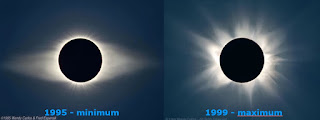The DSLR camera can easily be rotated to any angle. The Sun is round, so you'd think that just getting the Sun properly centered would be enough. Wrong! The corona during solar minimum (which we are approaching) is elongated along the ecliptic.
 |
Corona at solar minimum (left) and maximum (right).
Ecliptic is oriented along horizontal axis.
|
The Sun's motion in the sky due to Earths rotation (diurnal motion) is tilted relative to the ecliptic by the tilt of the Earths rotation axis. At the time of eclipse this angle is 20 degrees. For fixed mounts you want the long axis of the image roughly aligned with this motion so that there's as much image space as possible to contain the Sun's motion during the eclipse. It turns out that during this particular eclipse there is yet another reason for orienting the camera like this - and that reason is named Regulus!
Regulus is a bright (mag. 1.4) star, which - by fortunate cosmic coincidence - will be situated just 1.3 degrees from the Sun during totality. That can make for a nice visual: having a distant star embedded in the outer reaches of the corona. (It also helps a lot during image processing). I don't know if Regulus will be visible (and how much so) in my setup, but I'd like to give it a try. Below is shown the field-of-view (FOV) with my setup. The long axis of the image is aligned with the diurnal motion. The corona will be nicely framed, with the long equatorial extensions reaching out along the ecliptic. Regulus will also be well positioned.
 |
| Simulated field of view with my setup (Nikon D300, f=400mm). The bright star to the left is Regulus. |
The time it takes for the Sun to move from the left-most edge to the center of my FOV is 6 minutes and 3 seconds, see the illustration below. I can get perfect framing during mid-eclipse by placing the edge of the crescent Sun precisely at the left edge of the DSLR viewfinder at the correct time. With totality lasting just over two minutes this time is five minutes before it starts. After arriving at the final location, I'll just have to calculate the precise time of second contact, then do this final telescope aiming 5 minutes before that time. This will be the final adjustment required and then I can ignore the imaging setup completely - confident of perfect framing and being able to enjoy the eclipse with my own senses!
 |
Placing the crescent Sun at the left edge of the FOV precisely 5 minutes before
totality starts will result in perfect framing at mid-eclipse. |



No comments:
Post a Comment